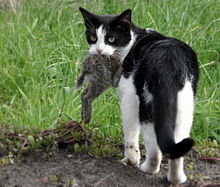Hyperpredation

Hyperpredation, also known as hypopredation, is when a generalist predator increases its predation pressure as a result of the introduction of a substitute prey.[1] Hyperpredation has been proven, for instance, in lab settings using two hosts and a parasitoid wasp.[2] Prey that require more handling time than they are worth in terms of nutritional value leads to hyperpredation. In severe circumstances, predators that fed on such prey went extinct.[3][4] Introduced Eastern cottontails cause an apparent competition with the European hare, as a result this along with the red fox being their main predator causes hyperpredation.[5]
Examples
After the invasion of feral pigs, golden eagles (which had inhabited the islands due to DDT wiping out the more territorial Bald eagle population) began preying heavily on the alien species. Another prey on the islands, the Island fox, nearly went locally extinct due to the predation pressure from the golden eagles. These incidents happened in the California Channel Islands.[6]
Causes
Theoretical research indicates that this increased predation may be sufficient to have a demographic impact on prey populations. The empirical data on hyperpredation that are now available are only applicable to situations where the introduction of a feral prey led to an overexploitation of the local prey. The most common cause of hyperpredation is apparent competition between the native and alien prey.[7]
See also
References
- ^ Smith, A.P.; Quin, D.G. (1996). "Patterns and causes of extinction and decline in Australian conilurine rodents". Biological Conservation. 77 (2–3): 243–267. Bibcode:1996BCons..77..243S. doi:10.1016/0006-3207(96)00002-x. ISSN 0006-3207.
- ^ Bonsall, M. B.; Hassell, M. P. (July 1997). "Apparent competition structures ecological assemblages". Nature. 388 (6640): 371–373. Bibcode:1997Natur.388..371B. doi:10.1038/41084. ISSN 1476-4687. S2CID 4408060.
- ^ SHIGEMIYA, YUSUKE (2004-02-06). "Reversible frequency-dependent predation of a puffer, Takifugu niphobles (Pisces: Tetraodontidae), related to spatial distribution of colour-polymorphic prey". Biological Journal of the Linnean Society. 81 (2): 197–202. doi:10.1111/j.1095-8312.2003.00276.x. ISSN 0024-4066. S2CID 82893144.
- ^ Holt, Robert D. (1977-10-01). "Predation, apparent competition, and the structure of prey communities" (PDF). Theoretical Population Biology. 12 (2): 197–229. Bibcode:1977TPBio..12..197H. doi:10.1016/0040-5809(77)90042-9. ISSN 0040-5809. PMID 929457.
- ^ Balestrieri, Alessandro; Remonti, Luigi; Prigioni, Claudio (2006-03-10). "Local feeding specialization of the red fox ( Vulpes vulpes ) in response to eastern cottontail ( Sylvilagus floridanus ) introduction (NW Italy)". Hystrix, the Italian Journal of Mammalogy. 16 (2). doi:10.4404/hystrix-16.2-4349. ISSN 0394-1914.
- ^ Roemer, Gary W.; Coonan, Timothy J.; Garcelon, David K.; Bascompte, Jordi; Laughrin, Lyndal (November 2001). "Feral pigs facilitate hyperpredation by golden eagles and indirectly cause the decline of the island fox". Animal Conservation Forum. 4 (4): 307–318. Bibcode:2001AnCon...4..307R. doi:10.1017/S1367943001001366. hdl:10261/41728. ISSN 1469-1795. S2CID 55719636.
- ^ Zhang, Jimin; Fan, Meng; Kuang, Yang (2006-09-01). "Rabbits killing birds revisited". Mathematical Biosciences. 203 (1): 100–123. doi:10.1016/j.mbs.2006.01.004. ISSN 0025-5564. PMID 16529776.
